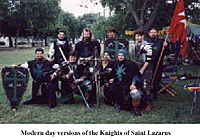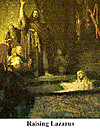 Early Origins
Early Origins
According to ancient tradition, the birthplace of the Order of Saint Lazarus was a leper hospital, constructed outside the walls of Jerusalem by the High Priest John Hyrcanus who ruled over the Jewish people between the years 135 and 105 BB. Letters patent issued in 1343 by John, Duke of Berry (later King of France under the name John II "the Good") attest to the tradition that the Brotherhood was founded in the year 72 AD.
Putting this fanciful origin aside, most historians agree with Pope Pius IV who wrote in in his bull Inter Assiduas that the Order existed in 369 AD during the papacy of St. Damasus I, when St Basil the Great was Archbishop of Caesarea. Basil is considered the legendary Father of the Order since he founded a large hospital for lepers near Caesarea.
Headquartered since the fifth century at Acre and Caesarea, the Hospitallers of Saint Lazarus built their principal hospital at Jerusalem in 530 AD. Here they cared for and protected pilgrims to the Holy Places, and especially directed their efforts to the comfort and treatment of lepers. Their Ladre, or Leper House, was located outside the walls of the city near the postern of Saint Lazarus, on what was believed to be the site of the ancient hospital founded by John Hyrcanus.
 After the fall of Jerusalem to the Crusaders in 1098, leprous knights of the Orders of the of St John, of the Temple and of the Holy Sepulchre, and other sufferers of similar dread diseases, were placed under the care of the of Saint Lazarus. Since the disease progressed very
slowly and because the hospitals required protection against the infidels as well as brigands and marauders, it was inevitable that the warrior patients would convert the Order into a Knightly militia, as well as a religious brotherhood. Hence, the year 1098 AD is considered the
official birth date of the Military and Hospitaller Order of Saint Lazarus of Jerusalem as a chivalric order.
After the fall of Jerusalem to the Crusaders in 1098, leprous knights of the Orders of the of St John, of the Temple and of the Holy Sepulchre, and other sufferers of similar dread diseases, were placed under the care of the of Saint Lazarus. Since the disease progressed very
slowly and because the hospitals required protection against the infidels as well as brigands and marauders, it was inevitable that the warrior patients would convert the Order into a Knightly militia, as well as a religious brotherhood. Hence, the year 1098 AD is considered the
official birth date of the Military and Hospitaller Order of Saint Lazarus of Jerusalem as a chivalric order.
The Medieval Period - The Middle East
The Order was held in great esteem by the Christian Kings of Jerusalem, and by all those who came in touch with their work of charity and protection. Baldwin IV, the leper King of Jerusalem, was especially generous to the Order, but gifts of lands and kind were received from men and women of all ranks. So great was the military reputation of the leper knights that they were entrusted with the defense of the castles of Kharbet el Zeitha and Madjel el Djemeriah. But wherever there was fighting between Christians and infidels, knights of the Order rallied to the support of the Holy Cross. They considered themselves the "living dead", these "men who walked alone"; final death in the defense of the Faith held no terrors for them.
 So renowned was the Order and its work of mercy that after the fall of Jerusalem on 1187, Saladin the Great took the hospital of the Order under his personal protection. The Moslem conqueror permitted the poor of the city who could not pay ransom to leave the walls of Jerusalem
by the Gate of St. Lazarus and take refuge in the Hospital of the Order.
So renowned was the Order and its work of mercy that after the fall of Jerusalem on 1187, Saladin the Great took the hospital of the Order under his personal protection. The Moslem conqueror permitted the poor of the city who could not pay ransom to leave the walls of Jerusalem
by the Gate of St. Lazarus and take refuge in the Hospital of the Order.
In 1191, during the peace between Saladin and the Crusaders, the Order established itself at the coastal city of St. Jean d'Acre, formerly known as Ptolemais. In this location the Order secured sovereign rights over a portion of the city outside its walls. Its members built a fortress-hospice and a church called the Church of Saint Lazarus des Chevaliers. They were also granted Saint Lazarus' Tower and the Church of Saint Lazarus near Caesarea. The Pope and other temporal rulers recognized the Order of Saint Lazarus as a sovereign power.
With the renewal of the war between the Christians and the Moslems, the Order gained added laurels, but at a sad price. After sustaining severe losses in many engagements, most of the leper knights of the Order were slain in the Battle of Gaza in 1244. Those of the knights who were not present at that ill-fated battle joined the Crusaders who remained to fight a forlorn hope. They accompanied St. Louis IX of France in his Egyptian Crusade and took part in his expeditions against Syria during the years 1250 to 1254.
When St. Jean d'Acre finally fell to the Muslims in 1291, the existence of the Order in the Holy Land ceased. After several convolutions typical of the knightly orders in the post-Crusader era, with convolutions, devolutions and a labrynthine passage of memberships, obedience and allegiance, the Order has persisted to the current day, devoted still to humanitarian work.
Humanitarian Work
In recent years the expansion of the Order and its humanitarian activities have taken a new direction. Aid to the handicapped and to the aged has been added to the Order's pursuit of its traditional mission in the field of leprosy. In New Zealand the Order is directly involved in Pacific-area programs against leprosy and donates medical supplies to various island leprosaria. In addition, the Order has purchased land and established two Saint Lazarus Villages for old people. The Grand Priory of Finland/Sweden operates a Special Volunteer Ambulance Corps for young drug addicts and directly sup-ports a medical and religious mission in Mugaea, Kenya. The Grand Priory of Alsace operates and supports various dispensaries in Cameroon as well as a leprosarium. The Hungary Priory in Exile supports a Hungarian Mission Hospital in Taiwan as well as a school for handicapped children there. Among the more noteworthy projects undertaken by the Order were those of the German and Luxembourg jursidictions. In the early 1980's these two organized weekly transports to Poland of basic food and medical supplies in the Order's own 38-ton trucks. These same trucks have latterly been seen delivering badly needed supplies to refugees of the Balkan conflicts.
References
The work of the St. Lazarus Hilfswerk has been admirably highlighted by Peter Bander van Duren in his book Orders of Knighthood and of Merit,. de Beaugourdon, Jean. A Brief History of the Order of Saint Lazarus, 1983 Weaver-Hazelton, Alan. The Order of Saint Lazarus -- A Short History, 1981
Back to Cry Havoc #36 Table of Contents
Back to Cry Havoc List of Issues
Back to MagWeb Master Magazine List
© Copyright 2001 by David W. Tschanz.
This article appears in MagWeb (Magazine Web) on the Internet World Wide Web. Other military history articles and gaming articles are available at http://www.magweb.com